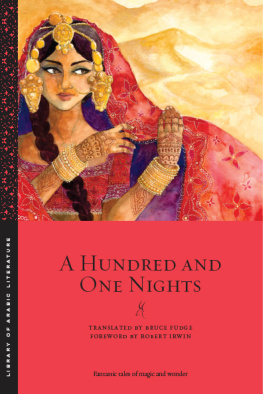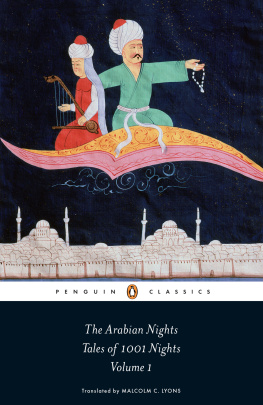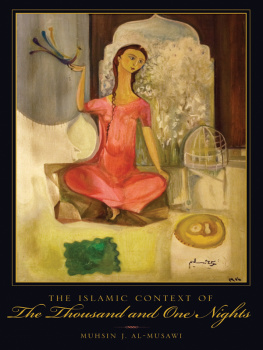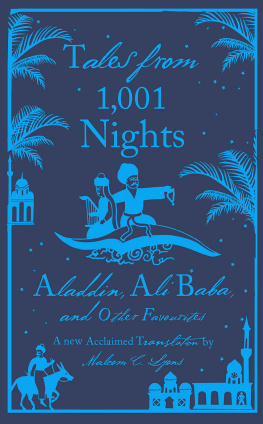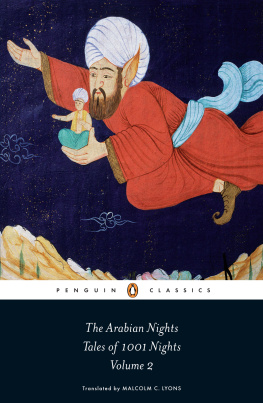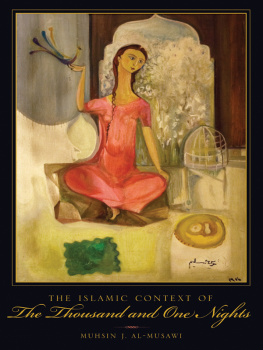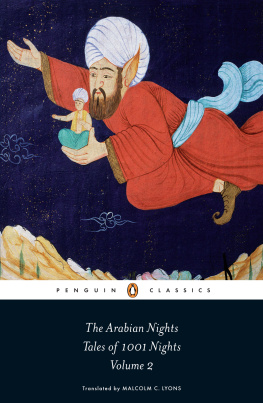Contents
Page List
Guide

A HUNDRED AND ONE NIGHTS
LIBRARY OF ARABIC LITERATURE
EDITORIAL BOARD
GENERAL EDITOR
Philip F. Kennedy, New York University
EXECUTIVE EDITORS
James E. Montgomery, University of Cambridge
Shawkat M. Toorawa, Yale University
EDITORS
Sean Anthony, The Ohio State University
Julia Bray, University of Oxford
Michael Cooperson, University of California, Los Angeles
Joseph E. Lowry, University of Pennsylvania
Maurice Pomerantz, New York University Abu Dhabi
Tahera Qutbuddin, University of Chicago
Devin J. Stewart, Emory University
EDITORIAL DIRECTOR
Chip Rossetti
DIGITAL PRODUCTION MANAGER
Stuart Brown
ASSISTANT EDITOR
Amanda Yee
FELLOWSHIP PROGRAM COORDINATOR
Amani Al-Zoubi
LETTER FROM THE GENERAL EDITOR

The Library of Arabic Literature series offers Arabic editions and English translations of significant works of Arabic literature, with an emphasis on the seventh to nineteenth centuries. The Library of Arabic Literature thus includes texts from the pre-Islamic era to the cusp of the modern period, and encompasses a wide range of genres, including poetry, poetics, fiction, religion, philosophy, law, science, history, and historiography.
Books in the series are edited and translated by internationally recognized scholars and are published in parallel-text format with Arabic and English on facing pages, and are also made available as English-only paperbacks.
The Library encourages scholars to produce authoritative, though not necessarily critical, Arabic editions, accompanied by modern, lucid English translations. Its ultimate goal is to introduce the rich, largely untapped Arabic literary heritage to both a general audience of readers as well as to scholars and students.
The Library of Arabic Literature is supported by a grant from the New York University Abu Dhabi Institute and is published by NYU Press.
Philip F. Kennedy
General Editor, Library of Arabic Literature
ABOUT THIS PAPERBACK
This paperback edition differs in a few respects from its dual-language hardcover predecessor. Because of the compact trim size the pagination has changed, but paragraph numbering has been retained to facilitate cross-referencing with the hardcover. Material that referred to the Arabic edition has been updated to reflect the English-only format, and other material has been corrected and updated where appropriate. For information about the Arabic edition on which this English translation is based and about how the LAL Arabic text was established, readers are referred to the hardcover.
A HUNDRED AND ONE NIGHTS

TRANSLATED BY
BRUCE FUDGE
FOREWORD BY
ROBERT IRWIN
VOLUME EDITORS
PHILIP F. KENNEDY
MAURICE POMERANTZ

| NEW YORK UNIVERSITY PRESS New York |
NEW YORK UNIVERSITY PRESS
New York
Copyright 2017 by New York University
All rights reserved
Library of Congress Cataloging-in-Publication Data
Names: Fudge, Bruce, 1967 translator.
Title: A hundred and one nights / translated by Bruce Fudge ; foreword by Robert Irwin.
Other titles: Miat laylah wa-laylah. English.
Description: New York : New York University Press, 2017. | Series: Library of Arabic literature | Includes bibliographical references and indexes.
Identifiers: LCCN 2017026047 (print) | LCCN 2017024579 (ebook) | ISBN 9781479873234 (pbk.) | ISBN 9781479894963 (Ebook) | ISBN 9781479808526 (Ebook)
Classification: LCC PJ7760.M53 A35 2017 (ebook) | LCC PJ7760.M53 (print) | DDC 892.7/34dc23
LC record available at https://lccn.loc.gov/2017026047
New York University Press books are printed on acid-free paper, and their binding materials are chosen for strength and durability.
Series design and composition by Nicole Hayward
Typeset in Adobe Text
Manufactured in the United States of America
10 9 8 7 6 5 4 3 2 1
CONTENTS
FOREWORD
ROBERT IRWIN
This collection of wonder tales is known to us via a number of North African manuscripts, whose origins can be traced to the tenth century and earlier. In its opening frame story, Shaykh Fihrs the Philosopher tells a tale which begins with a beautiful youth called Zahr al-Bastn (Flower of the Gardens) being fetched by an Indian at great expense from the Eastern land of Babel. For the inhabitants of the medieval Maghreb, Asia was a place of romance and India was preeminent as a territory of mysteries and marvels. India was also the setting for strange adventures in several stories in the Thousand and One Nights. The compiler of A Hundred and One Nights was not very familiar with oriental geography and thus, for example, the Indian finds the beautiful youth after disembarking at the port near the city of Khorasan. But Khorasan did not in fact have a port, but was an inland province without a shoreline.
Be that as it may, the storytellers shaky grip on oriental geography was padded out in the tales that follow with a beguilingly imaginative toponymy. Adventures were to be had in the Land of Flowers, the Palace of the Eagle, the Valley of Jinn, the Valley of Strangers, the Palace of Lights, the Valley of Blood, and the Amalekite Palace. Some adventurers set sail on the Sea of Darkness, while others disembarked on the Camphor Island. In the Thousand and One Nights stories are often set in identifiable locations within Baghdad, Cairo, and Damascus, but A Hundred and One Nights shows little interest in actual North African locales: cities like Fez, Tunis, and Algiers are nowhere to be found here. Wastelands are the preferred settings for adventures in which men roam as ostriches do. The land kills those who dont know it well, and it is almost always dangerous to go to sleep in this sort of territory. It is a land of mirage where melancholy dwells. However, Cairo is the setting of The Story of the Young Egyptian and his Wife, while Baghdad and the harem of the Abbasid Caliph al-Mutaim feature in The Story of Gharbat al-usn and the Young Egyptian, and the city also features in The Story of the Four Companions.
Not only did marvels occur in distant lands, but they also happened long ago.
As the fourteenth-century philosopher-historian Ibn Khaldn noted, North Africa was a region that abounded in ruins. In the stories of A Hundred and One Nights there are repeated references to the buildings of the Amalekites, a people borrowed from the Old Testament and added to the Arab pseudo-history of pre-Islamic Egypt, in which they featured as its fabulous conquerors and its pharaohs. The treasure of Camphor Island was guarded by a sword-wielding automaton whose mechanism was set in motion centuries ago. Ruins and tombs in the stories bear moralizing messages that warn of the perishability of material wealth and the inevitability of death. So it is that the treasure hunters discover a royally robed corpse and beside it a tablet on which is written, I am Imlq the Younger. I have ruled and I have vanquished; I have given gifts and I have withheld them; I have lived a noble and comfortable life; I have freed slaves and deflowered virgins. All this I did until the Almighty God decreed that my time had come, and look at me now. Let this be a lesson to all who would take heed: Do not be seduced by the world. It will only dupe and deceive you. And in another tale Najm al-iy ibn Mudr al-Mulk enters a mysterious dome in which there is tomb on which is written:

